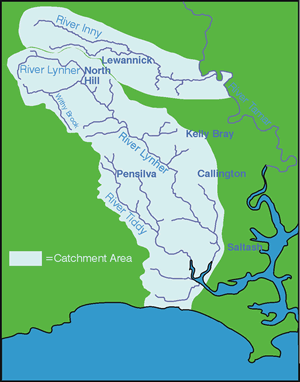River Catchments - LYNHER and TIDDY
The River Lynher is 34km long, rising at a height of 280m on Bodmin Moor and flowing into the Tamar Estuary at Plymouth. It drains a 245km2 catchment and has four main tributaries, one of which - the River Tiddy - supports a population of Atlantic salmon. There are many smaller tributaries including Deans Brook, Withey Brook, Marke Valley and Darleyford streams and Kelly Brook. 75% of the Lynher catchment is populated by specialist dairy farms. In addition, there are also a small number of beef and sheep farms and some arable land producing potatoes and maize, both crops having a significant water demand in the summer
There is light silty clay loam soil throughout much of the catchment, with an underlying geology predominantly of slate, limestone and grit in addition to granite on Bodmin Moor. This geology dictates low primary permeability and porosity which, in turn, limits groundwater flow and storage. The River Lynher is "a hard working river"; historical mining activities (particularly in the headwaters) have led to the contamination of watercourses to varying degrees by metalliferous compounds such as zinc and copper.
Arable farming, particularly potato and maize cultivation, has been increasing which can result in soil erosion leading to poor water quality and the subsequent siltation of Salmonid spawning gravels. Few fields in the catchment are truly level so bare soil in winter is easily washed down the slopes in heavy rains. On the light silty soils, gullies are easily formed acting as pathways for the transfer of large quantities of soil and nutrients from the land to adjacent water courses.
The River Lynher is an EU designated Salmonid fishery throughout much of the catchment. It supports both a rod and line, and commercial licensed net fishery for migratory salmonids (Atlantic salmon and Sea trout); the river also supports a Brown trout fishery. Stock monitoring data obtained from the Environment Agency indicates that over the last 20 years the salmon population, particularly the multi-sea winter stock component, has undergone a severe decline. Further concerns have been raised with regard to a shortfall in spawning targets and low juvenile survival from fry to par stage (Salmon Action Plan, EA 1998).
The Lynher estuary is a designated Site of Special Scientific Interest (SSSI) and a Special Protection Area (SPA). Many species can be found here, including rarer species such as the kingfisher, otter, dipper, avocet, black tailed godwit and the triangular club-rush.
CRP Advisers visited 129 farms and riparian owners extending from Bodmin Moor at Tregirls down to the Notter Bridge on the A38 over the 4 year period of the Cornwall Rivers Project. Management plans were written for an area covering 8,181 hectares and 206km of watercourses from small streams and ditches to the main river. Topics covered during advisory visits were always farm specific so they were relevant to the individual farm; however several issues were common to most of the farms. The top of the catchment saw a focus on fertiliser use including soil testing, fencing and river bank management, whilst the lower sections covered these topics and also the removal of Himalayan Balsam which is becoming a nuisance on the main river. All land owners visited were asked if they are familiar with invasive plants to ensure prompt removal by the best means if they were found.
Over 16.9km of riverbank have been fenced with £23,816 financial help from grant monies available under CRP. This fencing allowed for stock impact on the river to be reduced and controlled. Other grant assisted works include a diverter that was installed to re-direct dirty water away from a stream and a gateway has been re-positioned in an arable field to prevent soil loss through it.
A river walk was held on the main River Lynher at Callington Newbridge in the summer 2003.
Several stretches of the River Lynher are owned by private owners who either rent out the farm land or have estates that run the fishing. These Estates were offered River Plans which allowed an adviser to walk the river with the owner to discuss management of the river for fish and improving the habitat for all wildlife. These and all the owners of stretches of river that were able to be fished were offered entry into the Angling 2000 scheme. Most of the River Lynher beats are run by Liskeard and District Anglers. The catchment has one or two pockets of land that have not been visited under CRP due to time and resource constraints.
The River Tiddy is the main tributary of the River Lynher and was also targeted under the CRP. The response to cold calling was good with the majority of farmers being interested in the project and wanting an advisory visit. The farms on the River Tiddy are mainly a mix of livestock farms; although most also have some arable ground where cereals and fodder crops are grown. Key issues included clean and dirty water separation and reducing the impact of stock through the correct management of manures and restricting the damage to riverbanks.
